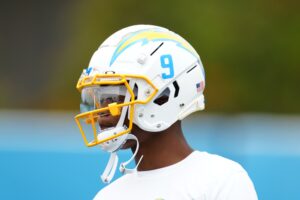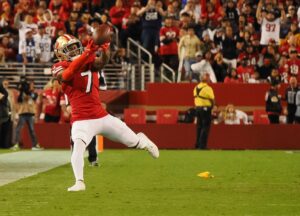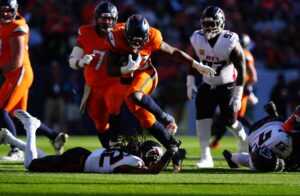Everyone always wants to find the next great young running back in fantasy football, and Cam Akers could be that guy. After a relatively slow start to his rookie season, the second-round pick dominated down the stretch in 2020. Can he carry that momentum into 2021 and become the proverbial heir to Todd Gurley?
[pickup_prop id=”6004″]
Cam Akers Fantasy Football Profile
Despite all the hype, Cam Akers’ season-long numbers don’t really jump off the page. Appearing in 13 games, the rookie finished his season with 625 rushing yards and two touchdowns on 145 carries to go with 11 receptions for 123 yards and a touchdown. These numbers made him the RB45 in PPR formats, but that doesn’t tell the full story.
After battling injuries early in the season, Akers absolutely dominated in the final four games of the regular season. From Weeks 13-17 (Akers missed Week 16 to injury), the running back averaged 21.5 carries per game and saw an additional 2.8 targets per game while playing in 63-79% of the snaps. This usage continued into the postseason, as Akers recorded a combined 42.2 fantasy points in two playoff games.
This is obviously a small sample, but there is reason to believe it will carry over into 2021. Akers and fellow running back Darrell Henderson both battled injuries throughout the year, but Akers was clearly the top option when both backs were healthy, as illustrated in this fantastic thread. Sean McVay loves using a workhorse running back when he has a player he trusts, and Akers could very well be that player.
Can We Trust Small Samples?
If Akers is able to even come close to maintaining his late-season workload, then volume alone should ensure him a low-end RB1 floor. However, we are going off a very small sample, and we don’t know how predictive that workload actually is. Fortunately, we do have a similar case we can analyze.
At this point last year, everyone in the fantasy football community was hoping for Miles Sanders to break out in Year 2. Much like Akers, Sanders was a second-round pick that started his rookie season on the bench before tearing up fantasy in the final weeks of the season.
Sanders didn’t live up to expectations in 2020, but that wasn’t due to a lack of opportunity. Astonishingly, Sanders finished fifth in the league in snap percentage (71%), meaning that the coaching staff tried to extrapolate 2019’s finish over a full season. The results weren’t there, but that had more to do with the dumpster fire that was the 2020 Philadelphia Eagles offense than Sanders himself.
https://twitter.com/betonthegame/status/1407398023005605889?s=20
Sanders’ success shows that we can trust small samples, and McVay’s coaching history confirms that he is willing to use a three-down workhorse. From 2017 to 2018, Todd Gurley was the unquestioned star of fantasy football. In 2017, he finished as the runaway RB1 while playing in a staggering 76.3% of the offensive snaps. Gurley “fell” to RB3 in 2018, but that’s only because he missed time to injury. The massive workload was still there, and Akers can earn a similar volume as the leader of this offense.
Expecting a 75% snap share is a little ridiculous, and that high workload is what led to the premature end of the Todd Gurley Era. I don’t expect Akers (or anyone not named Christian McCaffrey) to see that type of workload, but Akers could very well end up with a 65-70% share of the running back touches.
Projecting Volume
We know that Akers will probably be the lead back in Los Angeles, but how many opportunities will he actually have? Volume is just as important as talent in fantasy football, so let’s take a look at what Los Angeles likes to do on offense.
When adjusting for game script and situation, the Los Angeles Rams were one of the most balanced teams in the league from a run/pass standpoint. Keep in mind that this is how McVay called games with a quarterback he didn’t trust and with the best defense in the league. The Rams moved heaven and earth to get a better quarterback in Matthew Stafford, and defensive performances tend to regress to the mean. Both of these factors mean that there will be fewer rushing attempts for Akers, but there could be more scoring opportunities.
https://twitter.com/DLPatsThoughts/status/1407776206947246081?s=20
With this in mind, it’s time to do some rough napkin math. Los Angeles Rams running backs averaged 24 carries per game last year, but that number will go down. For now, let’s say they’ll average 22 carries per game. If Akers gets 65-70% of those touches, that means he’s looking at an average of 14-16 carries per game. Extrapolated over a 17-game season, this means that Akers should finish with roughly 260 carries for 1,170 yards and eight touchdowns.
Of course, running the ball is only one part of the game. Targets are far more valuable than carries, especially in PPR formats. This is the biggest red flag surrounding Akers, as he finished his rookie season with just 11 receptions on 14 targets. Even during his strong finish, he never saw more than four targets in any given game.
Akers will see more than 14 targets in 2021, but I don’t see him becoming a target monster in the passing game. The Florida State product never recorded more than 30 receptions in any given collegiate season, while Todd Gurley only had one season with 60 or more receptions. Akers’ history and McVay’s scheme are both working against him here, so he’ll probably max out at 40 receptions and 320 yards.
Bottom Line on Cam Akers in Fantasy Football
Ultimately, Cam Akers has what it takes to break out in 2021. He earned a lead role in the tail end of his rookie season, and both Miles Sanders and Sean McVay’s previous tendencies show that there is a pretty good shot Akers retains that workload moving forward. Volume sets the floor, and this many projected opportunities per game practically guarantee that Akers is going to finish as a top-12 back, barring health.
However, the lack of work in the passing game does put a limit on his overall ceiling. Akers hardly saw any work as a receiver last year, and his collegiate profile suggests that this will never be a featured part of his game. Even if he does see the majority of the running back targets, Sean McVay’s scheme simply doesn’t feature the running back as a receiving option all that often. This keeps out of the discussion for a top-five finish unless he significantly outperforms expectations in the touchdown department.
FantasyData currently has Akers as the RB11 in average draft position, right in the same tier as guys like Aaron Jones, Antonio Gibson, and Joe Mixon. It’s impossible to predict the Packers without knowing the fate of Aaron Rodgers, so I would happily take Akers over any of the three aforementioned running backs. Cam Akers should give you a top-12 finish, even if he doesn’t have RB1 overall potential for fantasy football.
Main photo:
Embed from Getty Images






